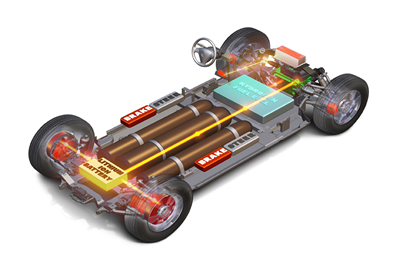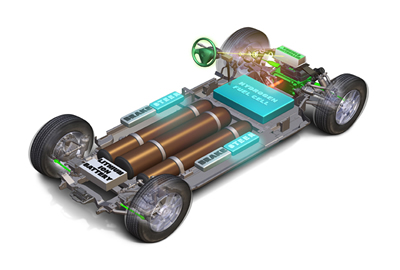
|
 |
|
Last Updated: Aug 28th, 2006 - 01:36:21 |

NEXT-GENERATION FUEL CELL SYSTEM PROPELS GM'S SEQUEL
DETROIT - With a 25-percent more powerful fuel cell stack, GM's next-generation fuel cell power system helps Sequel achieve a 300-mile range and 0-60 mph acceleration in less than 10 seconds, while emitting only water vapor.
 |
| The Sequel Powertrain Under Deceleration Stores Braking Energy Much Like the Prius |
"Sequel is the first fuel cell vehicle in the industry that delivers the range and performance people expect from their current vehicles, bringing us that much closer to commercialization," said Byron McCormick, executive director of GM's Fuel Cell Activities.
Sequel's fuel cell stack and power module were designed and developed by GM engineers in Honeoye Falls, N.Y. The fuel cell power module is significantly simpler and more efficient than the module GM used to set a new world distance record for fuel cell technology in 2004 with a run of 6,025 miles through 14 European countries. The fuel cell power module consists of the actual fuel cell stack, the hydrogen and air processing subsystems, the cooling system and the high-voltage distribution system. This power module delivers 73 kW of high-voltage power for the electric traction motors, as well as auxiliaries like HVAC (heating, ventilation and air conditioning), by-wire electronics and the battery.
"The system design has evolved and the components are becoming simpler, which is helping drive down the cost of technology and bringing us one step closer to reality," said Daniel O'Connell, head of GM Fuel Cell Product Engineering in Honeoye Falls.
Hydrogen introduced into the fuel cell is now directly converted to electric power to drive unprecedented torque control of all wheels. The two rear wheel hub motors including two inverters, as well as the power inverter module for the front electric motor, are developed by GM's Advanced Technology Center in Torrance, Calif. A high-voltage, lithium ion battery system provides extra power to the three electric motors during acceleration. It also stores power regenerated during braking to help extend the vehicle's overall mileage range. Engineers at a GM fuel cell facility in Mainz-Kastel, Germany, integrated the fuel cell propulsion system into the vehicle package. The engineers linked the drive motor development with the rest of the system for a complete, vehicle-level, system solution. This led to an increase in the overall efficiency. It makes more power with less hydrogen, improving the performance and day-to-day operation. GM's next-generation fuel cell also uses a new air intake system that is more efficient, quieter and lighter than its predecessor. The fuel cell stack, along with the cylindrical hydrogen storage tanks, is housed in a unique "skateboard" floor. Additional radiators are located under the Sequel's hood, directly behind the headlights, and in the rear of the vehicle, behind the taillights. These necessary design features help pull heat away from the fuel cell system, allowing Sequel to operate in hotter ambient temperatures.
"A fuel cell system is more efficient than an internal combustion engine, but its energy conversion is totally different and requires much more heat to be removed via the coolant," said Lothar Matejcek, project manager, GM Fuel Cell Activities, Mainz-Kastel. "With its three openings in the front, the extra opening for the HVAC and the two additional openings in the rear, you can easily recognize that Sequel was designed for heat rejection. We expect excellent performance at high ambient temperatures, typical of what you would experience in the desert."
Longer range
 |
| Under Acceleration, The Hydrogen Fuel Cell Powers the Vehicle |
Sequel's 300-mile range is made possible by advances in high-pressure storage that enable the vehicle to carry 8 kg of hydrogen, more than double that of GM's HydroGen3 fuel cell vehicle. Developed in conjunction with Quantum Technologies (Nasdaq: QTWW), of Irvine, Calif., three lightweight, carbon composite tanks store hydrogen at 10,000 psi (700 bars), compared to 5,000 psi (350 bars) in Hy-wire, Sequel's predecessor. The larger tanks also enable a better ratio of stored hydrogen mass versus fuel storage system mass. Within the novel skateboard floor are three cylindrical tanks. The carbon-fiber material, supplied by Toray Industries, of Tokyo, Japan, is strong and wraps the all-composite tanks. It provides a storage tank that is lighter than comparable metal tanks. The all-composite tanks have been validated to extremely stringent safety and performance standards representing harsh operating environments.
"Our skateboard chassis with the three-tank design is an excellent approach to providing a vehicle with a 300-mile vehicle range, without compromising overall interior and trunk space for the customer," said Chris Borroni-Bird, director of GM's Design and Technology Fusion Group and program director for Sequel. "Hydrogen storage technology will continue to evolve and, as improvements are made, we will translate this into greater range and smaller packaging designs."
The electrical architecture of the Sequel consists of three systems. A high-voltage system provides power for the drive system, while a 42-volt system supplies the by-wire features. A 12-volt system powers conventional vehicle accessories such as the audio system and interior lighting. A high-voltage lithium ion battery system is an integral component in the Sequel's propulsion system. It helps power the drive system at certain times, but also stores energy from regenerative braking, and thereby extends range. The lithium ion battery, supplied by Saft, of Bagnolet, France, offers 65 kW of peak power and weighs 65 kg (143 pounds).
Global effort
Hundreds of GM engineers and researchers and nearly 200 suppliers around the world have contributed to the technology infused in the Sequel's fuel cell power module and propulsion system.
"The giant strides in efficiency and production viability, as seen in Sequel, simply would not have been possible without this large network of capabilities," said McCormick. "Bringing these great minds together for such an important cause demonstrates GM's commitment to fuel cells."
Discuss this article on AutomotiveForums.com
© Copyright 2006 by AutomotiveArticles.com
Top of Page
|
|
 |
|

 AF Project Vehicle | Corporate
AF Project Vehicle | Corporate



 AF Project Vehicle | Corporate
AF Project Vehicle | Corporate

